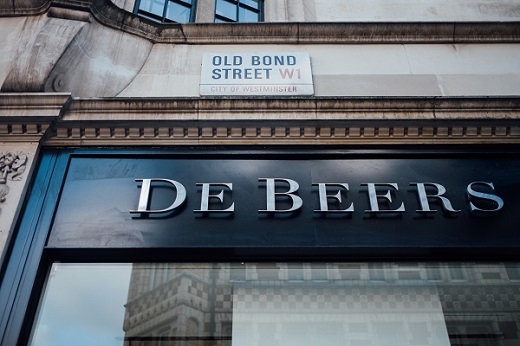|
|
De Beers Reveals Plans for Retail, Botswana
Interview with new CFO Sarah Kuijlaars
Aug 5, 2021 5:12 AM
By Joshua Freedman
|
|
|

RAPAPORT... De Beers had a strong first half of 2021, with sales in its rough and other businesses benefiting from the diamond market’s sharp recovery. The miner also made some key strategic moves during the period in its retail and rough operations that signal a change in mindset for the company.
However, challenges remain, and there are still questions about the motivations behind some of those recent decisions and how it expects to navigate the market in the second half.
Following the July 29 earnings release, Rapaport News met — virtually — with Sarah Kuijlaars, who took over as chief financial officer of the De Beers group in September 2020. The interview sought to uncover management’s perspective on its plan for the retail division, its recent string of special-stone purchases, and its prolonged negotiations with Botswana, among other pressing issues.
You recently appointed one CEO in charge of both De Beers Jewellers and De Beers Forevermark. Do you have plans to align those businesses more closely?
We felt historically the impact of [the De Beers] brand was too fragmented. So [it’s now] two jewelry houses under the single brand. And indeed, very recently we’ve announced Céline Assimon as CEO of those jewelry houses. So I think that allows us to [have] a much more integrated approach and to be clear about which of the products we want to present to which customer, so it’s a more aligned and integrated approach and so there’s no risk of cannibalization.
The highest-quality [goods] go into De Beers Jewellers and then the [lower-level] premium [goods] go into De Beers Forevermark. We’re now looking, now we’ve got that integrated approach, [at] how we can reinforce the whole supply chain.
Do those two businesses currently operate as two distinct teams?
Yes. Historically, they’ve been very distinct. Now, with one CEO, we’re looking at what makes sense [in] bringing them together. It comes back to being very distinct about the product we want to reach [each] distinct customer.
So could it be that you’d bring those two businesses into one team and one division?
They’re all within the brand and consumer markets division. Now we have one CEO, so definitely there will be more convergence. For example, now you can toggle online from De Beers Jewellers to De Beers Forevermark. So it’s very clear it’s all within the same brand and the same De Beers family.
Do De Beers Jewellers stores currently carry any Forevermark products, and if not, could they in the future?
No. It comes back to that distinct consumer and it’s about how we keep those consumers separate, because they are so distinct, looking for distinct products. De Beers Jewellers is really the top end of the market. We don’t want to dilute that impact by offering the premium Forevermark products.
Do you foresee Forevermark being diminished in terms of its prominence as a brand, and the De Beers name gaining greater prominence?
I think it will always be De Beers Forevermark, whereas historically we’ve been quite comfortable with just Forevermark. Some consumers haven’t understood that Forevermark has been part of De Beers. So it’s just strengthening that link to the ultimate customer.
What is your outlook for global rough production? Are there enough rough diamonds on the market at the moment? And if there are shortages, for how long do you expect that to continue?
We’re very focused on our own production. [A total of] 15.4 [million carats is a] really stellar result for the first half year and obviously significantly up from last year.
We have had real operational issues. At the beginning of the year, particularly in southern Africa, we had extensive rainfall, which disrupted production. We’ve had Covid-19 shut-ins, we’ve had electricity issues. So that has impacted our production. On the macro level, we see flat to potentially slightly declining production, as some marginal producers have shut. We all know the Argyle story in Australia. [The Rio Tinto mine ceased operations last year.] We are very much focused on how we can optimize our production, because demand has picked up and we want to meet that demand.
Are those operational disruptions at your mines still there?
No, those really impacted the first quarter of the year. But it’s fair to say, working with Covid-19 is absolutely impacting how we work day-to-day. Gahcho Kué in Canada was shut down for 21 days because of Covid-19. Clearly, we want to work really safely for every single employee. We’re getting much better at working with Covid-19. But...southern Africa is still in the midst of it. Botswana and Namibia have had terrible [infection-]rate increases recently, which is absolutely impacting our employees and the mechanics of getting people to work safely.
What is the latest with the negotiations over the new contract with the Botswana government?
We’re obviously working with them. It’s been very difficult with Covid-19. We want to negotiate face-to-face, and that hasn’t been possible. I haven’t yet visited Botswana or the Debswana [De Beers’ joint venture with the Botswana government] team, but we’re absolutely working with them to see how we can get a face-to-face meeting in the [fourth quarter] this year. Both sides are absolutely focused on enabling an extension of these agreements.
If travel continues to be difficult, do you anticipate that the current contract could be rolled over for yet another year into 2022?
That’s what happened last year. We’re very much focused on trying to negotiate this year, seeing which parts we can negotiate on [Microsoft] Teams, et cetera. But things are opening up. So can we find a country [where] we can all [meet] to work through those last elements? Both sides are incredibly positive about reaching a resolution.
Do you have any plans yet for selling the 1,098-carat diamond that was discovered at the Jwaneng mine on June 1?
No. We’re still working with Debswana and the government to work out what is the best route for what is clearly an amazing stone.
We’ve seen quite a trend recently of De Beers buying up some expensive blue stones, particularly from the Cullinan mine. What is behind that strategy?
I’m not sure it’s a new strategy. We’ve been fortunate to access some really exceptional stones…. We’re working with Diacore [a sightholder and De Beers’ 50:50 partner on the stones] so we can ensure that we obtain the stones and then manufacture and polish them and [implement] an effective route to market.
How do you plan to sell them?
It’s early days. We only purchased the last one a couple of weeks ago. Clearly we’ve got to take some time to work out the whole manufacturing...process with Diacore — how we can use the De Beers brand and Diacore to ensure that we access the right consumers for these exceptional stones.
Do you now have a department dedicated to buying and partnering on these blue stones?
No, but it comes from the relationship with Diacore, the relationship with the midstream on accessing the stones and then working with our colleagues in brands and consumer markets, which are very much focused on the high-net-worth individuals and the exceptional stones that come through.
Are you actively looking for more opportunities like that? Is De Beers actively in the market for rough special stones?
We’re actively in the market of diamonds. Where there are unique opportunities, we’re in a position to grab them when they come up.
Would you be able to buy run-of-mine rough if De Beers ran into shortages or further problems in production?
In theory, we could, but we’re very comfortable with our portfolio of mines. This was a unique opportunity. Paul [Rowley, executive vice president for diamond trading,] said, “These don’t come along often, Sarah,” and I was going, “Hang on a minute, we’ve had six in the last six months or whatever.” So this isn’t a trend, it’s just an exceptional opportunity that we were in a position to optimize.
Is there any update on your plans for the Damtshaa mine in Botswana? I know you are considering a number of options, one of which would be to sell it. Have you made any progress on that?
Damtshaa is part of Debswana, so all those decisions have to go through the Debswana governance.
What is being planned for the holiday season in terms of marketing and marketing budget?
We’ve had this real rebound in the beginning of the year. We expect that to continue, and the holiday period coming up is key in our principal markets of the US, China and beyond. And you see the buoyancy there. So there will be a significant marketing spend to support that. Marketing spend this year is one of the highest because we see that pull from the consumers.
Sentiment in the industry has been unusually high this year. Is De Beers taking a bit more of a cautious approach in the third quarter just before the holiday season approaches?
We don’t comment on any forward-looking prices, but every sight we take a very careful, informed decision about how we position our products and our price. The first half year was buoyed, as there was restocking and pent-up demand, which I think will calm down a bit in the second half. But we’re going into the holiday season, which is a really important season for us.
What’s happening in terms of attending the sights? Is it still semi-remote, with viewings in Antwerp and Dubai?
We are continuing our flexible approach. Sightholders have got into Gaborone [recently] for the sights, but we’re providing alternatives in Europe and elsewhere.
Is that a new way of doing sights that’s here to stay?
It’s going to be the balance between what the sightholders want and also what our host government, Botswana, wants. Physically, Gaborone today is really difficult to get in and out of. It’s been a brutal impact of Covid-19. So I would imagine some elements of that flexibility will remain, but like everything else in this world, we’re going to have to see how we come out of this pandemic and adapt.
Main image: A De Beers Jewellers store on Old Bond Street, London. Inset: Sarah Kuijlaars. (Ben Perry/Armoury Films/De Beers)
|
|
|
|
|
|
|
|
|
|
Tags:
Céline Assimon, consumer brands, De Beers, De Beers Forevermark, De Beers Jewellers, Forevermark, Jewelry, Joshua Freedman, mining, Rapaport News, retail, Sarah Kuijlaars
|
|
|
|
|
|
|
|
|
|
|

|
|